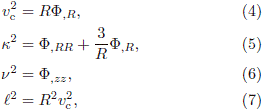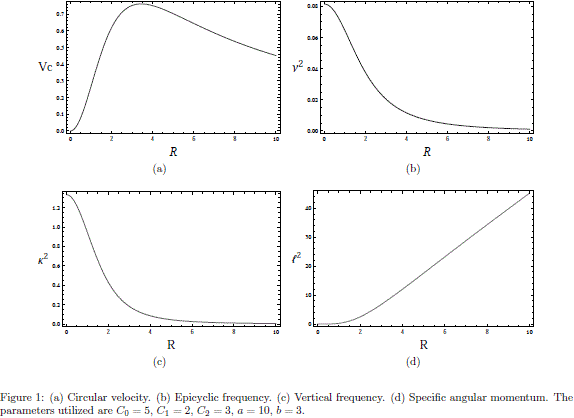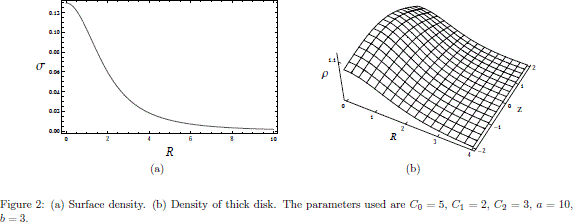Servicios Personalizados
Revista
Articulo
Indicadores
-
 Citado por SciELO
Citado por SciELO -
 Accesos
Accesos
Links relacionados
-
 Citado por Google
Citado por Google -
 Similares en
SciELO
Similares en
SciELO -
 Similares en Google
Similares en Google
Compartir
Revista de la Academia Colombiana de Ciencias Exactas, Físicas y Naturales
versión impresa ISSN 0370-3908
Rev. acad. colomb. cienc. exact. fis. nat. vol.37 no.144 Bogotá jul./set. 2013
CIENCIAS FÍSICAS
1 Facultad de Ingeniería Mecatrónica, Universidad Santo Tomás, Bucaramanga, Colombia, E-mail: framsol@gmail.com
2 Escuela de Física, Grupo de Investigación en Relatividad y Gravitación, Universidad Industrial de Santander, A. A. 678, Bucaramanga, Santander, Colombia, E-mail: guillego@uis.edu.
RESUMEN
Se presenta una nueva familia de discos gruesos newtonianos estables a partir del método de desplazamiento, corte, llenado y reflexión construidos en (González & Letelier, 2004; Vogt & Letelier, 2005). Soluciones de la ecuación de Laplace en coordenadas cilíndricas son consideradas, éstas representarán el campo gravitacional de objetos con momentos multipolares externos solamente. Se definen y calculan las cantidades físicas en el plano del disco, tales como, la frecuencia epicíclica, k, la frecuencia vertical, n, y la velocidad circular, uc de las partículas. Además, se determina la densidad superficial de masa, s, la densidad del disco grueso, r, y el criterio de estabilidad de los discos gruesos a través del momentum angular o el criterio de Rayleigh (Rayleigh, 1917; Landau, 1987). Finalmente, se representan las propiedades físicas para algunos parámetros considerando sólo hasta el término cuadrupolar en la expansión multipolar del potencial gravitacional.
Palabras clave: Disco grueso, Rayleigh, frecuencia epicíclica, multipolos.
ABSTRACT
We present a new family of stable thick discs from known displace, cut, fill and reflect method (González & Letelier, 2004; Vogt & Letelier, 2005) is presented. Solutions of the Laplace equation in cylindrical coordinates are considered, these one represent the gravitational field of objects with only external multipole moments. The physical quantities in the plane of the disk, are defined and calculated such as, the epicyclic frequency, k, the vertical frequency, n, and the circular velocity, uc of particles. The surface density, s, density of thick disk, r, and stability of thick disks through of specific angular momentum or Rayleigh criterion (Rayleigh, 1917), and (Landau, 1987) were calculated. Finally, the physical properties are shown for only some parameters considering only until quadrupolar term in the expasion gravitational potential multipolar
Key words: Thick disk, Rayleigh, epicyclic frequency, and multipole.
1 Introduction
The obtention and interpretation of solutions of Laplace and Poisson equations constitute an arduous and interesting problem. During many years, it has been obtained by various methods, a large number of solutions of these equations. In particular, over the past four decades the collection and physical analysis of axially symmetric exact solutions of Laplace equations that represent discoidal configurations has raised a variety of works.
The Newtonian gravitational potential of a thick disk can be obtained by a simple procedure such as, the displace, cut, fill and reflect method, presented by (González & Letelier, 2004), and then expanded by (Vogt & Letelier, 2005), both cases they were based on known of displace, cut, reflect method, considered of (Kuzmin, 1956) . Said method mathematically is based on making the transformation z Y h(z) + b, wherein b is a constant and h(z) an even function of z.
In the other hand, as is suggested by a wide variety of observational evidences, many astrophysical objects can be modeled as axially symmetric bodies with prolate or oblate deformation (Cooray, 2000; Davies & Birkinshaw, 1986; Fassano & Vio, 1991; Merritt, 1996; & Mosenkov et al, 2010). For example, some galaxies with a large disc component can be assumed as axisymmetric oblate bodies with a large quadrupolar moment and, in some cases, with a significant octupolar deformation due to the remaining components like the halo (Helmi, 2004).
In agreement with the above considerations, this paper we shall focus on the introduced by González and Letelier method (González & Letelier, 2004). The paper is organized as follows. First, in section 2, we present a summary of the main aspects of the generalized thick disk. Then, in the section 3, we find the physical quantities in the plane the disk such as circular velocity uc of particles, the epicyclic frequency, k, the vertical frequency, n, surface density s, and specific angular momentum, l. In next section, section 4, we present the differential equations of motion. Later in section 5, we review a new family of thick disks that meet the physical quantities and thus we construct a stable model. Finally, in section 6, we summarize the main results
2 Thick Disk Model
The gravitational potential F(R, z), in the case of Newtonian gravity in the vacuum, is a solution of the Laplace Equation, this is

where (R, j, z) are the usual cylindrical coordinates. Af ter we make the transformation z Y h(z) + b, the above equation becomes (González & Letelier, 2004)

where premiums indicate differentiation with respect to z, G is the Gravitational constant and r = r(R, z) is the mass density. To ensure that the disc is located in CzC ≥ a, the function h(z) outside the disk must be a linear function of z such that h'(z) = 1.
For the case of thick disks the function h(z) must be selected in such a way that F and its first derivatives be continuous across the plane z = 0. Let us take a function h(z) defined as (González & Letelier, 2004)

Hence, by taking the function h(z) above defined we can generate disks of thickness 2a located in the region –a ≤ z ≤ a.
3 Physical Quantities
The physical quantities of interest are evaluated in the plane the disk, these are the circular velocity, uc , the epicyclic frequency, k, and the vertical frequency, n, of small oscillations about the equilibrium circular orbit. They are found with the equations (Binney & Tremaine, 2008)

In the case of thin disk the expression for the surface density, s, can be obtained taking the function h(z) = CzC, and using the well-known relation of Gauss's theorem, one can write

evaluated at z Y 0+.
When CzC ≥ a the function h(z) is a linear function of z such that h'(z) = 1. Hence, its second derivative is zero. Then the mass density vanish outside the disk.
Since the first derivative is continuous at CzC = a and the second derivative piecewise constant we have that the mass density, r, will be well defined inside the disk, (González & Letelier, 2004)

In this expression CzC ≤ a and r = 0 for CzC > a.
4 Equations of Motion
The motion of a test particle in a gravitational field described by (14), obeys the relations (Ramos-Caro, González & López-Suspes, 2008)

where Fef f is the effective potential, given by

Here, l = R2 is the axial specific angular momentum that is conserved as a consequence of the axial symmetry. The second integral of motion is the total specific energy
is the axial specific angular momentum that is conserved as a consequence of the axial symmetry. The second integral of motion is the total specific energy

According to eqs. (10)-(13), the motion is restricted to a three dimensional phase space (R, z, VR). This fact enable us to introduce the Poincaré surfaces of section method, in order to investigate the trajectories of test particles. Note that the orbit of particle is confined to the plane defined by the effective potential, this plane is known as meridional plane.
5 One New Family of Thick Disk
We consider the axially symmetric gravitational field generated by a stellar body multipolar moments. In spherical coordinates (R, q), its potential has the form

where m X Z+ and Cn are constants related with the multipolar moments (2n poles), we are interested in the future in test particle motion in the exterior of source, thus we regard only external multipolar moments. The relation with cilyndrical coordinates are

with R ≥ 0, R X [0, h), z X (–h, h) and 0 ≤ q ≤ p.
As an example, if we chose the monopolar, dipolar, and quadrupolar terms, ie m = 2, thus we obtained the quantities


Here C0, C1, C2 are monopolar, dipolar, and quadrupolar terms, respectively. According to these equations we find the range

wherein C1 X R and C0 > 0, so that the specific angular momentum and circular velocity are positives. Whereas the frecuencias epicyclic and vertical we find the intervals

respectively. Finallly, for surface density we obtained

For example, we choose the following values for parameters C0 = 5, C1 = 2, C2 = 3 (prolate deformed objects), a = 10, b = 3 and G = 1, which satisfaced all quantities physicals and the model is stable. In the Fig.1, we show (a) Circular velocity. (b) Epicyclic frequency. (c) Vertical frequency. (d) Specific angular momentum. In Fig.2 we presented (a) Surface density. (b) Density of thick disk, for our stable model. The disk is stable in the plane to radial and vertical perturbations of its radius, Fig. 1(b) o Fig.1(d) and Fig.1(c), respectively. The circular velocity, and densities also have a behaviour appropriate Fig.1(a), Fig.2(a) and Fig.2(b).


6 Conclusiones
We present the mass density r, of a new family of thick disk considered displace, cut, fill and reflect method (González & Letelier, 2004; Vogt & Letelier, 2005). Also calculed of the physical quantities in plane the disk as circular velocity uc of particles, the epicyclic frequency, k, the vertical frequency, n, surface density s, and specific angular momentum, l, the latter is used to determine the stability of the model (Rayleigh criterion).
We consider only the first three terms of multipolar expansion potential, ie the mass monopole, and terms dipolar and cuadrupolar. Thus, we can find an interval for which it meets all the physical quantities of the model, section 5. Then we chose some particular parameters for graphics of physical quantities of a specific model (Fig.1 and Fig.2). Additionally, we presented the equations of evolution of motion (section 4), work that we think developed in a later article to complete the models.
Referencias
Binney, J. & Tremaine, S., 2008. Galactic Dynamics. 2nd ed. Princeton University Press. [ Links ]
Cooray, A. R., 2000. Galaxy clusters: oblate or prolate? MNRAS 313, 783-788. [ Links ]
Davies, R. L., & Birkinshaw, M., 1986. NGC 4261 - A prolate elliptical galaxy. Ap. J. 303, L45-L49. [ Links ]
Fasano, G., & Vio, R., 1991. Apparent and true flattening distribution of elliptical galaxies. MNRAS 249, 629-633. [ Links ]
González, G. A. & Letelier, P. S., 2004. Exact general relativistic thick disks, Phys. Rev. D 69, 044013. [ Links ]
Helmi, A., 2004. Is the dark halo of our Galaxy spherical? MNRAS 351, 643-648. [ Links ]
Kuzmin, G. G., 1956. Model of the steady Galaxy allowing of the triaxial distribution of velocities, Astron. Zh. 33, 27. [ Links ]
Landau, L.D. & Lifshitz, E.M., 1987, Fluid Mechanics, 2nd ed. Pergamon Press, Oxford, Sec. 27. [ Links ]
Merritt, D., 1996. Chaos and the Shapes of Elliptical Galaxies. Sience 271, 337-340. [ Links ]
Mosenkov, A. V., Sotnikova, N. Ya., Reshetnikov, V. P., 2010. 2MASS photometry of edge-on spiral galaxies - I. Sample and general results. MNRAS 401, 559-576. [ Links ]
Ramos, J. F. , González, G. A. & López-Suspes, F., 2008. Mon. Not. R. Astron. Soc., 371, 1873. [ Links ]
Rayleigh, L., 1917. On the Dynamics of Revolving Fluids. Proc. S. Soc. Lond. Ser. A, 93:148. [ Links ]
Vogt, D. & Letelier, P. S., 2005. New models of general relativistic static thick disks, Phys. Rev. D 71, 084030. [ Links ]
Recibido: 2 de abril de 2013
Aceptado para su publicación: 6 de septiembre de 2013













